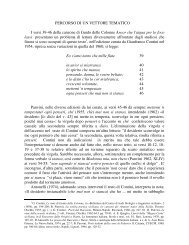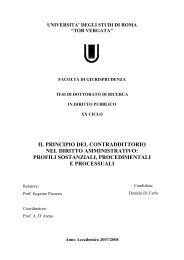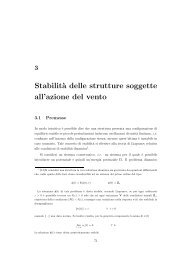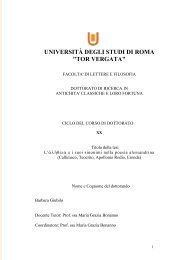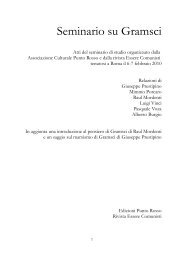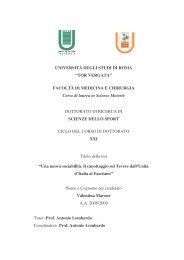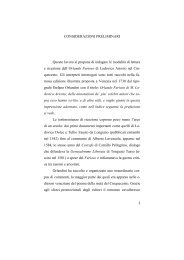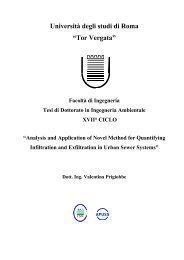Diagnosis, treatment and follow-up of the carpal ... - Home page | ART
Diagnosis, treatment and follow-up of the carpal ... - Home page | ART
Diagnosis, treatment and follow-up of the carpal ... - Home page | ART
Create successful ePaper yourself
Turn your PDF publications into a flip-book with our unique Google optimized e-Paper software.
Neurol Sci<br />
Table 7 Key points<br />
Non-pharmacological <strong>treatment</strong><br />
The use <strong>of</strong> ultrasounds is controversial (SOR C)<br />
Questions remain on whe<strong>the</strong>r neutral angle wrist splinting is better<br />
than extension splinting<br />
A s<strong>of</strong>t h<strong>and</strong> brace have a short-term effectiveness on symptoms <strong>and</strong><br />
functionality (SOR A)<br />
Full-time splint wear does not lead to greater improvement as<br />
compared to night-only wear<br />
deficit or severe anomalies on electrodiagnostic examination<br />
(SOR B) [13].<br />
No r<strong>and</strong>omised controlled studies have ever been<br />
reported in <strong>the</strong> literature comparing surgical versus no<br />
<strong>treatment</strong>. In a recent review <strong>of</strong> 209 studies on <strong>the</strong> <strong>treatment</strong><br />
<strong>of</strong> CTS published between 2000 <strong>and</strong> 2006, which<br />
regarded 32,936 interventions, 75% <strong>of</strong> patients reported <strong>of</strong><br />
complete symptom resolution or <strong>of</strong> mild residual symptoms<br />
after intervention, 17% reported mild improvement or<br />
no change, <strong>and</strong> 8% reported worsening [21].<br />
There are three r<strong>and</strong>omised controlled studies that<br />
compare surgical versus conservative <strong>treatment</strong> [40–42],<br />
two <strong>of</strong> which were included in a systematic Cochrane<br />
review [43]. In <strong>the</strong> studies included in <strong>the</strong> review [40, 42],<br />
<strong>the</strong> non-surgical gro<strong>up</strong> had been treated by h<strong>and</strong>–wrist–<br />
forearm splinting for 4 or 6 weeks. In <strong>the</strong> more-numerous,<br />
better-quality study, 71% <strong>of</strong> surgically treated patients<br />
experienced significant improvement after 3 months as<br />
compared to a 1.38 improvement (95% CI: 1.08–1.75) in<br />
favour <strong>of</strong> surgery [40]. This improvement still persisted<br />
after 6 <strong>and</strong> 18 months. In any case, it must be underlined<br />
that in this study, after 18 months 41% <strong>of</strong> patients in <strong>the</strong><br />
splinting gro<strong>up</strong> had undergone surgical <strong>treatment</strong>. The<br />
reviewers concluded that, although short-term (1 month)<br />
statistical data were only mildly significant, surgical<br />
<strong>treatment</strong> is more effective than conservative <strong>the</strong>rapies in<br />
preserving mid- to long-term improvement [43]. In <strong>the</strong><br />
study by Ly-pen et al. [41], <strong>the</strong> non-surgical gro<strong>up</strong><br />
underwent steroid <strong>treatment</strong> by local infiltration. Surgical<br />
<strong>treatment</strong> was significantly less effective in improving<br />
symptoms after 3 months (percentage <strong>of</strong> subjects with<br />
improvement equal to or higher than 20%; nocturne paraes<strong>the</strong>sia:<br />
94% with corticosteroids vs. 75% after surgery;<br />
daytime pain: 89 vs. 69%; compromised function: 88 vs.<br />
68%). However, after 6 <strong>and</strong> 12 month <strong>the</strong>re were no significant<br />
differences between <strong>the</strong> two gro<strong>up</strong>s.<br />
There are two surgical procedures:<br />
1. ‘‘Open <strong>carpal</strong> tunnel release’’ (OCTR) after curvilinear<br />
skin incision in <strong>the</strong> palm, which may be associated, in<br />
case <strong>of</strong> thickening <strong>of</strong> <strong>the</strong> external nerve sheath, to<br />
epineurotomy <strong>and</strong>, if cicatricial tissue is present within<br />
<strong>the</strong> nerve, to internal neurolysis to decompress <strong>the</strong><br />
single nerve fascicles.<br />
2. ‘‘Endoscopic <strong>carpal</strong> tunnel release’’ (ECTR), characterised<br />
by sectioning <strong>of</strong> <strong>the</strong> ligament from inside <strong>the</strong><br />
<strong>carpal</strong> tunnel, leaving <strong>the</strong> structures <strong>and</strong> skin plane<br />
above <strong>the</strong> tunnel intact.<br />
Two systematic reviews [44, 45] <strong>and</strong> two r<strong>and</strong>omised<br />
studies [46, 47] are available, which compare <strong>the</strong> two<br />
procedures. The conclusion is that, at <strong>the</strong> moment, <strong>the</strong>re is<br />
no evidence to s<strong>up</strong>port <strong>the</strong> s<strong>up</strong>eriority <strong>of</strong> ECTR over<br />
OCTR in providing short- <strong>and</strong> long-term symptom<br />
improvement <strong>and</strong> in leading to recovery <strong>of</strong> normal activities<br />
(LOE I, SOR A). At present, <strong>the</strong> decision on <strong>the</strong><br />
technique to be used seems to be basically linked to <strong>the</strong><br />
patient’s <strong>and</strong> surgeon’s preference.<br />
Contraindications to surgical intervention<br />
There are no specific contraindications to OCTR. The<br />
patient’s clinical condition must be stable before <strong>the</strong><br />
intervention. Pregnant women should postpone <strong>the</strong> intervention<br />
because symptoms <strong>of</strong>ten disappear after delivery.<br />
In contrast, ECTR is contraindicated [48]:<br />
1. In case <strong>of</strong> rheumatoid arthritis (<strong>the</strong> intervention may<br />
worsen <strong>the</strong> inflammatory process)<br />
2. In CTS secondary to recent trauma with symptoms<br />
suggesting <strong>the</strong> involvement <strong>of</strong> <strong>the</strong> median nerve,<br />
limited wrist extension <strong>and</strong> previous wrist intervention<br />
3. In case <strong>of</strong> recurrent tenosynovitis or o<strong>the</strong>r palmar<br />
inflammations (<strong>the</strong>se patients may benefit from neurolysis,<br />
which is only performed during OCTR)<br />
4. In case <strong>of</strong> D<strong>up</strong>uytren syndrome or in case <strong>of</strong> previous<br />
h<strong>and</strong> interventions<br />
5. In patients undergoing anticoagulant <strong>treatment</strong>,<br />
because with ECTR only compressive haemostasis<br />
may be achieved<br />
6. When <strong>the</strong>re is a marked involvement <strong>of</strong> <strong>the</strong> <strong>the</strong>nar<br />
motor branch, which makes ‘‘open’’ exploration<br />
necessary<br />
7. When <strong>the</strong> patient prefers to undergo general anaes<strong>the</strong>sia,<br />
which does not allow for <strong>the</strong> patient to report<br />
symptoms indicative <strong>of</strong> possible nerve lesions during<br />
<strong>the</strong> procedure<br />
8. In case <strong>of</strong> evident malformations or in <strong>the</strong> presence <strong>of</strong><br />
a mass.<br />
Complications associated with <strong>the</strong> interventional technique<br />
The frequency <strong>of</strong> complications varies from study to study,<br />
independently <strong>of</strong> <strong>the</strong> technique. Two literature reviews<br />
conclude that transient nerve disorders (neuroapraxia,<br />
123



